SPIR 2020-2021 (Volume II): Policing in the COVID-19 Pandemic
Summary and Key Findings
The Status of Policing in India Report (SPIR) 2020-2021, Volume II: Policing in the Covid-19 Pandemic covers a range of citizen-police interactions during the lockdown, the handling of the crisis, and the emergence of new challenges for the law enforcement apparatus. SPIR 2020-21 Volume-I, released in April 2021, covered policing in regions affected by conflict, extremism, or insurgency. The two SPIR volumes study policing during unusual and extraordinary circumstances.
This Volume of SPIR 2020-21 analyses data from a survey of common people and police personnel from Tier 1 and Tier II/ III cities of 10 states and Union Territories. The report also looks at the media coverage of the nature of policing during the initial phases of the national lockdown. Some of the key findings of a separate, rapid survey with migrant workers and relief workers from Delhi-NCR, Rajasthan and Gujarat have also been presented in this report.
It may be noted that all the findings of the report pertain to the first wave of the Covid-19 crisis in India in 2020, since the data collection was done in the months of October and November 2020.
Below are some of the key takeaways from the report:
Adherence to Rule of Law by the Police
One of the central features of a democracy is adherence to the rule of law. However, while this may exist as a governing principle on paper, the reality on the ground may be entirely different. This was also the case in the functioning of the police during the first wave of the pandemic, as is evident from the findings of the survey.
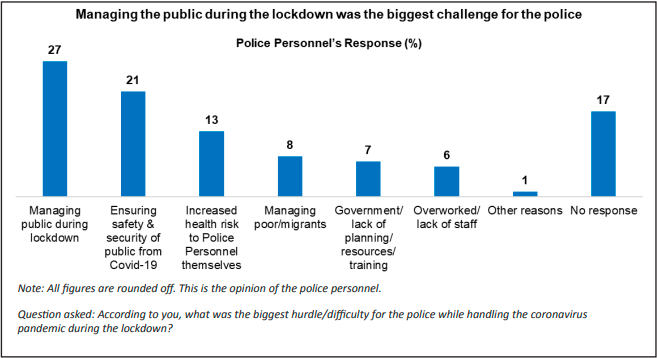
• Only one out of three police personnel reported being able to follow legal procedures completely while maintaining law and order and investigating crimes during the lockdown.
• The biggest challenge for the police during the lockdown was managing the people, as reported by more than a quarter (27%) of the police personnel. Personnel from Andhra Pradesh and Maharashtra reported that managing the poor and migrant workers was the second biggest challenge for them during the lockdown.

Police Excesses, Use of Force and Confrontations Between Police and the People
During the lockdown, use of force by the police and police brutality were commonly reported, even in cases of minor infringement of the strict lockdown rules. This inevitably led to confrontations between the police and the people. Additionally, there was an increased level of fear of the police among the common people:
• One out of three (33%) common people reported frequent confrontations between the civilians and the police during the lockdown.

• A majority of the common people (55%) reported fearing the police during the lockdown. Nearly three in five feared impositions of fine (57%) and being beaten by the police (55%).
Adverse Impact on Economically and Socially Disadvantaged Sections
The lockdown and the police action in its wake was invariably harsher on the already disadvantaged groups such as the poor, Dalits, tribals and Muslims. Firstly, these communities faced greater disadvantage generally due to the lockdown, having difficulty accessing essentials such as food or ration. Secondly, they were also more likely to be evicted as tenants. Worsening their woes was the discrimination they faced by the police during this period, as is evident from the findings:
• The poorest and lower classes were more than twice as likely as the rich to face a lot of difficulties in accessing basic needs during the lockdown.
• The poorest were also thrice as likely to report ‘many’ cases of forceful eviction of tenants during the lockdown, as compared to the rich. Amongst socio-religious groups, Dalits, Muslims and other minorities were most likely to be forcefully evicted during the lockdown.
• There was a clear class divide in the perceptions of the police during the lockdown. The poor and those belonging to lower class, were more fearful of the police during the lockdown. In particular, they were fearful of physical violence by the police. They were also more likely to see the police’s instructions during this period as threatening. The police personnel, on the other hand, were also more likely to report the poor localities as being least compliant with the lockdown rules.
• An overwhelming majority of common people (62%) and police personnel (71%) believed that the restrictions imposed during the lockdown applied equally to everyone. However, a significant proportion (29% people; 26% police personnel) felt that some people got away more easily. Poorer people are more likely to believe that curbs were not imposed equally for everyone.
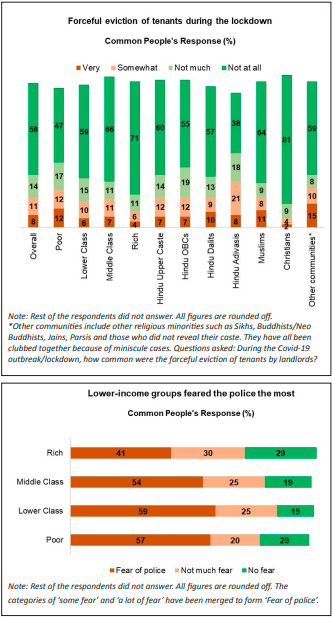
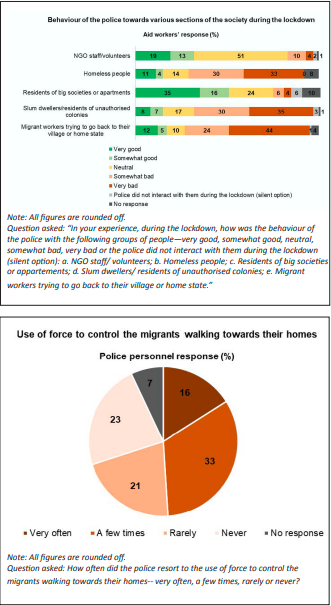
• With a higher visibility of the police at public spaces, nearly three in four (71%) people reported feeling secure. However, about one in five (18%) felt threatened. It was the poor and economically vulnerable who felt more threatened, indicating that they were disproportionately affected by increased policing.
• According to a separate, rapid study of relief workers, more than one-third of the aid workers believe that police behaved very badly with the homeless people, slum dwellers and migrant workers during the lockdown. One out of two aid workers also said that the police discriminated against Muslims during the lockdown, with 50 percent reporting high or medium levels of discrimination.
Plight of Migrant Workers
The migrant workers were arguably the worst hit during the first wave of the pandemic, and were left to grapple with the multiple challenges of economic insecurity, lack of support systems and absence of essential services. Their trauma was compounded by being away from homes and families. Thus, the surveys with the common people and police personnel also included some questions on the plight of migrant workers. This apart, some of the findings of a separate rapid survey of migrants and relief workers also point to greater levels of police brutality and excesses towards the migrants.
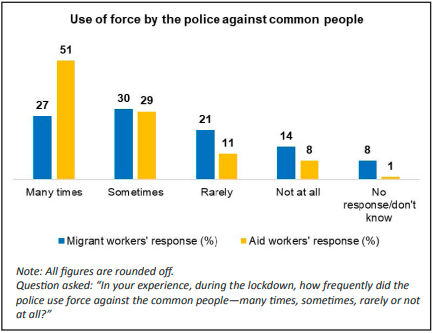
• Nearly one out of two police personnel (49%) reported having frequently used force against migrant workers travelling back home. Further, one in three police personnel (33%) frequently encountered situations where the migrants were trying to enter shelters, but police used force to prevent them from doing so.
• Nearly one out of four personnel (23%) reported being confused as to who would shelter the migrant workers while another 22 percent noted a lack of coordination with the district police.
• According to a separate rapid survey of migrant workers, the abrupt lockdown was not viewed favourably by the most severely affected people or those providing relief to them. Four out of five migrant workers and nearly an equal proportion of aid workers believe that if people were informed of the lockdown earlier, they would have faced lesser difficulties.
• The rapid study found that providing aid and distributing food, rations or essential provisions were the biggest form of support provided by the police in the time of crisis, according to both migrant and aid workers. Nearly sixty percent aid workers feel that police were highly or somewhat helpful in distributing food/ration.
• Nearly half of the migrant workers contacted for the separate rapid study faced assault by the police during the lockdown. Further, one in 10 migrant workers faced assault by the police while going back to their home states/villages. Like the migrant workers, the aid workers also reported assault to be the most common form of cruelty by the police during the lockdown. Eighty percent said police used force against common people many times or sometimes.
• According to the separate rapid study, overall, three out of five migrant workers (59%) and aid workers (61%) were satisfied with the work of the police during the lockdown. However, both groups were also of the opinion that there was excessive use of force by the police during this time. Nearly three out of five migrant workers (57%) and four out of five aid workers (80%) reported frequent use of force by the police against the common people during the lockdown.
Management of the Lockdown: Opinions of the Common People and Police
Even though the police enforced the lockdown rules and ensured compliance with the Disaster Management Act, 2005, the decisions on exact rules to be enforced did not fall within the purview of their work. The nature of the lockdown and the decision of enforcement timing were taken without consultation with state police forces. Some of the findings of the report show dissatisfaction with the rules and the manner in which they were enforced.

• More than three out of five people (64%) believe that a longer notice before the lockdown could have prevented the migrant crisis.
• Two out of five migrant workers (38%) believed that the strictness of lockdown rule enforcement by the police was inappropriate and harsh. Forty seven percent, however, believed that strictness was required for the safety and the police were doing their job. A significant proportion of aid workers (40%) also strongly felt that the unnecessarily strict lockdown rules were a big hindrance in the proper functioning of the police during this period.
People’s Appraisal of Police Work During the Pandemic
To gauge the level of satisfaction with the work done by the police and their overall assessment of policing during the lockdown, questions pertaining to people’s satisfaction, trust, experiences and perceptions about policing during the lockdown were asked:
• Overall, nearly nine in 10 common people (86%) rated the behaviour of the police during the lockdown positively. Out of this, a quarter (25%) said that the behaviour was very good and three out of five (61%) reported it to be good.
• Three out of four police personnel feel that surveillance increased a lot during the lockdown. A similar proportion of common people also reported an increase in police presence in their locality.
• The survey captures a broadly positive public perception of policing during the pandemic. Two in every five people (40%) considered the police to be highly efficient and 46% somewhat efficient in controlling the outbreak. However, the poor people were less likely to believe that the police were efficient.
• Overall, the pandemic seems to have improved the relationship between the police and citizens. Two in three people (66%) reported an improvement in the level of trust and around the same number (65%) reported an improvement in the image of the police following the lockdown. Around half of the common people surveyed felt that the police handled the situation efficiently despite the sudden nation-wide lockdown.
• Largely, people in Tier II/III cities had a better perception of the police during the lockdown, compared to Tier I cities. More people in smaller towns felt that the police were efficient in controlling the situation and that they were secure with their increased presence during the lockdown.
Crime During the Lockdown
With the imposition of the lockdown, it was seen that general crimes such as robbery, theft, murder, violent crimes, etc. went down drastically across the globe. However, the lockdown caused an increase in different categories of crimes such as cybercrimes and domestic violence, as is clear from the survey findings. However, it needs to be noted that these findings are restricted to the perceptions of the people and the police, regarding the rates of crimes and are not official statistics about the actual reported crime rate.
• Overall, the data shows that with fewer people venturing out, there was reportedly a substantial decrease in the crime rate of the country. Four in five police personnel reported a drop in the overall crime rate. A similar proportion of common people also reported a decrease in crime during the lockdown.

• While police personnel reported that crimes such as theft, robbery, kidnapping and murder reduced to a great extent, offences committed in private settings, such as domestic violence against women and cybercrimes, increased during the lockdown. One out of four police personnel reported an increase in domestic violence during the lockdown.
Police Preparedness and Working Conditions During the Lockdown
The sudden lockdown took a toll not only on the common people across the country, but also on the police personnel tasked with enforcing the lockdown. With low levels of preparedness through training, lack of resources, shortage of staff, etc., the personnel were generally ill-equipped to handle the mammoth task they were assigned. This is evident from the survey findings:
• Police personnel in Tier I cities were provided with better facilities during the lockdown compared to those in Tier II/III cities. Police in Tier I cities had higher provision of equipment for duty during the pandemic, better hygiene conditions, more insurance covers, safety arrangements such as special accommodation, higher proportion of personnel receiving special training and more departmentally arranged health check-ups during the lockdown. Personnel with comorbidities in these cities were also less likely to be posted in high-risk zones.
• While police personnel reported that crimes such as theft, robbery, kidnapping and murder reduced to a great extent, offences committed in private settings, such as domestic violence against women and cybercrimes, increased during the lockdown. One out of four police personnel reported an increase in domestic violence during the lockdown.
• A majority (56%) reported that the vulnerable police personnel were shifted to lowrisk zones or given complete rest, while two in five (37%) denied the same, indicating the lack of a uniform policy. However, more than four out of five (84%) agreed that police personnel with visible symptoms of Covid-19 were granted leave.

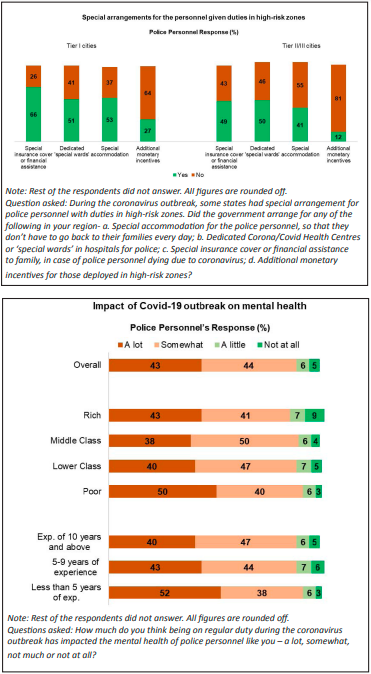
• Half of the police personnel (56%) claimed to have received a special training to deal with the public during the outbreak, while more than two in five (43%) disagreed.
• Covid-19 duty took a toll on the mental health of most of the police force, as nine in every 10 said that they were greatly or somewhat impacted by this.
• In general, southern states such as Kerala and Tamil Nadu were more proactive in providing special training to personnel during the pandemic. These states also ensured better availability of safety equipment such as PPE kits, etc. while states such as Bihar and West Bengal were least prepared under these parameters. Highlighting the challenges, half of the police personnel (52%) identified shortage of staff as a major hurdle. Consequently, the police force appeared to be overburdened, with four in five (78%) reporting to be working for at least 11 hours a day during the lockdown. More than a quarter (27%) reportedly worked for at least 15 hours a day during the lockdown.
Media Coverage of Policing During the Pandemic
The media played an important role as the disseminator of information during a period when access to many other sources of information were stopped. Therefore, the study included an analysis of the news coverage of policing during the pandemic. Key findings of this analysis are given below:
• A good amount of media coverage on policing during the lockdown --- one out of four news stories --- was about incidents of lockdown violation and the consequent action taken by the police. More than half of these news stories were reported within a month of the lockdown.
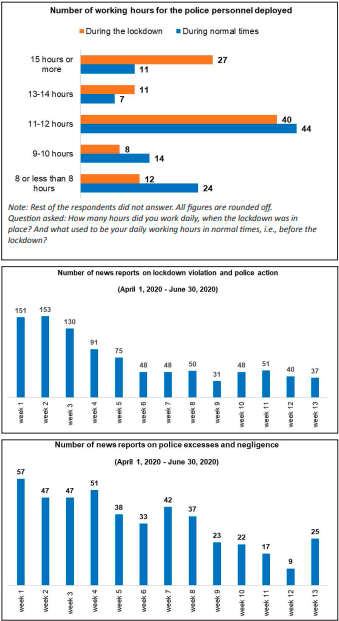
• News reports suggest significant governmental pressure on the police for very strict imposition of the lockdown norms using whatever means deemed necessary.
• Media stories strongly reflect the expanded role of the police during the lockdown. The police in almost all the states were involved in distributing food and essential supplies during the initial weeks. Also widely covered were reports of innovative policing, i.e., cops singing, dancing, running creative health awareness campaigns; distributing masks, medicines, etc. to the needy; paying surprise visits to citizens’ houses and celebrating their birthdays etc.
• Nearly one out of 10 news stories from the sample reports the police excesses and negligence during the lockdown. It is evident from media reports that migrant workers were most likely to be at the receiving end of police brutality during this period.
Media also reported that the police extensively used
• Media also reported that the police extensively used advance surveillance tools like drone cameras, face detection technology, GPS enabled systems like geofencing, etc. to enforce the lockdown. The growing reliance on advanced technology for policing received high praise from the media but few questions were raised pertaining to their legality, adherence to regulations, and data protection methods during this time.
• The analysis of media reports showed little to no critical assessment of government policies or police behaviour during the lockdown. While content analysis of the slant of media stories was not done in this study, the general analysis revealed few critical reports, except in cases of extreme police brutality such as custodial deaths
NEXT »
Excerpts from SPIR 20-21 (Volume II) Keynote Address: Justice Deepak Gupta >>



